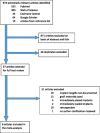A meta-analysis on the effect of implant characteristics on the survival of the wide-diameter implant
- PMID: 27747650
- PMCID: PMC5005654
- DOI: 10.1186/s40729-015-0030-2
A meta-analysis on the effect of implant characteristics on the survival of the wide-diameter implant
Abstract
The purposes of the study are to study the implant survival of the wide-diameter implant and to analyze if the length, the implant surface, or the placement location has any effect on its survival. Electronic databases were searched from inception to Dec 2014. Studies included in the review had implants placed in areas of adequate bone width and had clear inclusion and exclusion criteria for patient selection. Immediately placed and immediately loaded implants were excluded. A meta-analysis was done using the "random effects" model on the included studies. And, a meta-regression was used to evaluate the effects of location, length, and surface on the implant survival. Of the six studies selected, three evaluated surface-treated implants and three machined implants. The overall pooled survival rate of the wide implant is 96.3 %. The meta-regression showed that when using a wide implant, neither its surface nor its length nor its position in the maxilla or mandible adversely affected its survival (P > 0.05). This meta-analysis concluded that the location, length, and surface of the wide-diameter implant did not affect its survival and therefore suggested that when the conditions of the implant site corresponded to the inclusion criteria of our meta-analysis, choosing a wide-diameter implant in the posterior mandible or maxilla, where implant length may be limited by the nerve or the sinus, the use of a short implant regardless of its surface would not affect its survival.
Keywords: Implants in the mandible or maxilla; Short implants or long implants; Surface-treated or machined implants; Wide-diameter implants.
Figures
Similar articles
-
Survival of short implants is improved with greater implant length, placement in the mandible compared with the maxilla, and in nonsmokers.J Evid Based Dent Pract. 2012 Sep;12(3 Suppl):189-91. doi: 10.1016/S1532-3382(12)70035-0. J Evid Based Dent Pract. 2012. PMID: 23253845
-
Impact of Implant Length on Survival of Rough-Surface Implants in Nonaugmented Posterior Areas: A Systematic Review and Meta-Regression Analysis.Int J Oral Maxillofac Implants. 2019 Nov/Dec;34(6):1359-1369. doi: 10.11607/jomi.7509. Int J Oral Maxillofac Implants. 2019. PMID: 31711077
-
Impact of implant length and diameter on survival rates.Clin Oral Implants Res. 2006 Oct;17 Suppl 2:35-51. doi: 10.1111/j.1600-0501.2006.01349.x. Clin Oral Implants Res. 2006. PMID: 16968380 Review.
-
Implant stability measurement of delayed and immediately loaded implants during healing.Clin Oral Implants Res. 2004 Oct;15(5):529-39. doi: 10.1111/j.1600-0501.2004.01042.x. Clin Oral Implants Res. 2004. PMID: 15355394
-
15-year follow-up of short dental implants placed in the partially edentulous patient: Mandible Vs maxilla.Ann Anat. 2019 Mar;222:88-93. doi: 10.1016/j.aanat.2018.11.003. Epub 2018 Nov 15. Ann Anat. 2019. PMID: 30448466
Cited by
-
Comparative Evaluation of Dental Implant Failure among Healthy and Well-Controlled Diabetic Patients-A 3-Year Retrospective Study.Int J Environ Res Public Health. 2020 Jul 21;17(14):5253. doi: 10.3390/ijerph17145253. Int J Environ Res Public Health. 2020. PMID: 32708165 Free PMC article.
-
A Six-Year Prospective Comparative Study of Wide and Standard Diameter Implants in the Maxillary and Mandibular Posterior Area.Medicina (Kaunas). 2021 Sep 25;57(10):1009. doi: 10.3390/medicina57101009. Medicina (Kaunas). 2021. PMID: 34684046 Free PMC article.
-
Effectiveness of ultra-wide implants in the mandibular and maxillary posterior areas: a 5-year retrospective clinical study.J Korean Assoc Oral Maxillofac Surg. 2023 Feb 28;49(1):13-20. doi: 10.5125/jkaoms.2023.49.1.13. J Korean Assoc Oral Maxillofac Surg. 2023. PMID: 36859371 Free PMC article.
References
-
- Adell R, Eriksson B, Lekholm U, Branemark PI, Jemt T. Long-term follow-up study of osseointegrated implants in the treatment of totally edentulous jaws. Int J Oral Maxillofac Implants. 1990;5(4):347–59. - PubMed
-
- Albrektsson T. On long-term maintenance of the osseointegrated response. Australian Prosthodontic J Australian Prosthodontic Soc. 1993;7(Suppl):15–24. - PubMed
-
- Engquist B, Bergendal T, Kallus T, Linden U. A retrospective multicenter evaluation of osseointegrated implants supporting overdentures. Int J Oral Maxillofac Implants. 1988;3(2):129–34. - PubMed
-
- Jemt T, Lekholm U, Adell R. Osseointegrated implants in the treatment of partially edentulous patients: a preliminary study on 876 consecutively placed fixtures. Int J Oral Maxillofac Implants. 1989;4(3):211–7. - PubMed
Publication types
LinkOut - more resources
Full Text Sources
Other Literature Sources
Research Materials




